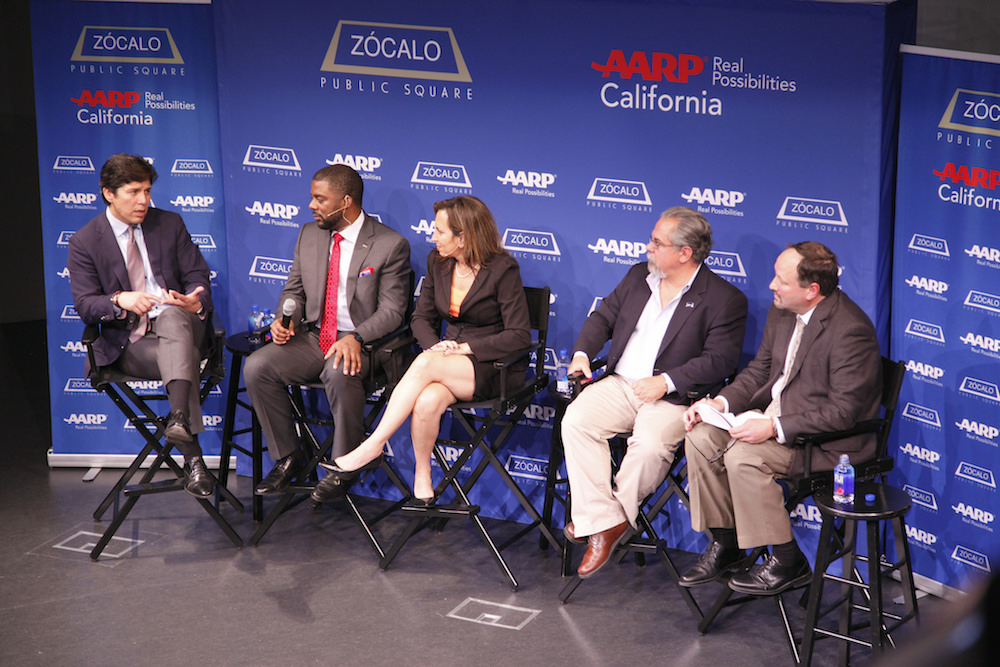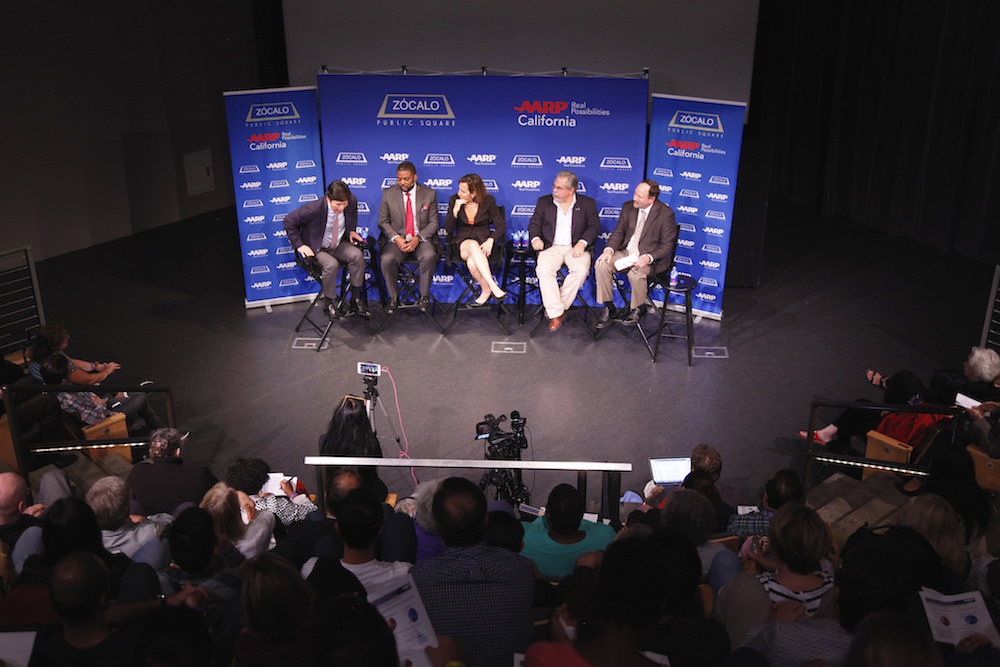
California’s sky-high housing prices haven’t just made it hard to find and afford a place to live. They’ve put pressures on the economy, the environment, transportation, and health that threaten the California dream itself, said panelists at a Zócalo/AARP event at the National Center for the Preservation of Democracy in Los Angeles.
The event—entitled “Are Housing Prices Destroying the California Dream?”—brought together a scholar, a politician, a leading journalist, the head of a nonprofit housing organization, and a national expert on housing to examine a crisis that the panelists said touches every person in every region of the state.
This problem “affects all ends of the economic distribution, and all ends of the age distribution,” said Gary Segura, dean of the UCLA Luskin School of Public Affairs, adding: “I am one of millions of Californians who cannot afford my house the day I retire.”
Moderator David Lesher, CEO and editor of the nonprofit media organization CALMatters, framed the conversation around three questions: “How big of a problem is housing? What’s the cause of the problem? And what are we going to do about it?”
The panelists said the housing crisis involves the intersection of many different problems: zoning, planning, taxation, environment, infrastructure, transportation, mental health, homelessness, demands on developers, financing, and Californians’ high expectations for the places where they live.
This complicated intersection makes the housing situation difficult to understand. One panelist, Kevin de León, president pro tem of the California State Senate, recalled a day he spent in downtown L.A. with a wide variety of people—from housing advocates to police and local officials—to learn more about housing and homelessness. “My conclusion was the following: The left hand didn’t know what the right hand was doing,” he said.
But that can’t be an excuse, given how high the stakes are. “We have a housing crisis, and it’s a big driver without a doubt when it comes to poverty,” de León said. He cited the statistic that a Californian who makes minimum wage would need to work three full-time jobs to afford the average two-bedroom apartment.
Another panelist, AARP housing policy expert Rodney Harrell, said that affordable housing is a national crisis, but it’s even worse in California. An AARP survey, he noted, found that almost two-thirds of Californians have thought about leaving the state because of high housing costs.
He said the heart of the matter is a lack of supply, but fixing it is not just a matter of building more places to live. “There are not enough housing units of the types that people need”—affordable, near jobs or transit, and with designs for people who may have special needs because of their age or health. And high costs leave people very vulnerable. “The folks I worry about most are the people who have not planned for an emergency—something happens to your spouse, you have a health crisis, you lose a job” and then you can no longer afford your housing.
Segura, of UCLA, spoke of the need to reduce the costs that local governments put on developers, by demanding they widen streets, provide parking, or take on wage issues as a condition of building housing. Such demands add to the cost of housing and make “pulling a building permit the most expensive thing you can do in California.”
He also argued that linkage fees, which make developers pay for affordable housing, reflect attempts by local governments to make up for some of the control and revenue they lost under Proposition 13, the 1978 ballot initiative that limited property taxes. While noting that it’s unpopular to free up developers, he warned, “We cannot use developers and development to solve all issues.”
Lisa Hershey, executive director of the nonprofit Housing California, said that too much public money goes into tax subsidies for our homes—she mentioned the mortgage interest rate deduction—and not enough into infrastructure, transit, access to schools, and livable community policies that stabilize neighborhoods, and keep people in their homes. “The stability of home makes everything else possible” in terms of improving people’s lives, she said.
She also lamented how efforts to address the housing crisis—by building more transit and housing—can end up pushing out longstanding residents of certain neighborhoods, as land values, rents, and home prices rise. Many Californians are being pushed out of established neighborhoods to places far from jobs, creating longer commutes.
De León noted that a development in Boyle Heights, which is part of his Senate district, was blocked because of concerns about such displacement. “People are thinking, ‘If I’m going to be displaced, where am I going to live? My cultural identity, my linguistic identity—everything is in this neighborhood, this block,’” he said.
Hershey and de León both touted a package of 15 bills that the legislature passed in the just concluded session, and that Governor Jerry Brown signed into law. It includes a dedicated funding source for affordable housing, a housing bond that will go to voters, and legislation that should speed up permitting in localities. De León said that the push on housing would be enhanced by other new laws that promote road and infrastructure repair, boost transit, add parks, and reduce pollution.
“This package we’ve moved forward—I’m hoping it will be the first step of many steps,” he said.
De León also noted that the housing package—in combination with previously allocated state money for the homeless and mentally ill and local measures for funding housing and homeless programs—meant that an unprecedented amount of money is flowing to address housing issues. But that doesn’t guarantee that local leaders will find ways to turn money into housing that meets people’s needs.
“At a macro level we can move all the capital that is necessary to catalyze and attract money,” de León said. “But if at the local level, the leadership is lacking, it just takes a really bad problem and makes it even worse.”
During a question-and-answer session with the audience, one person asked why, if California is producing so little housing, she sees so much development as she drives around.
Harrell, of AARP, responded that “not all supply is created equal—just because a building is going up, it doesn’t mean it has enough units that folks can afford.” And UCLA’s Segura noted that the housing being built is simply not enough for a state that’s reaching a population of 40 million.
Hershey, of Housing California, called this “a historic moment,” with opportunities to address the housing crisis given the resources, the focus on the problem, and “a gubernatorial campaign with several candidates who are interested in housing.”
But she cautioned that such a complex problem won’t be solved quickly. “This is the long game,” she said.
At that, Harrell added, “We all need to take part.”





Send A Letter To the Editors